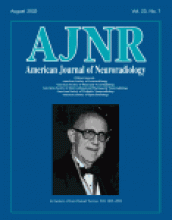Abstract
BACKGROUND AND PURPOSE: A decline in intrahemispheric cerebral white matter volume in children treated for brain tumors with cranial irradiation has been well documented. It was hypothesized that the development of the corpus callosum, the largest white matter commissure of the brain, would also be adversely affected after treatment with cranial irradiation in pediatric patients treated for medulloblastoma.
METHODS: After diagnosis, 35 patients (22 male and 13 female patients) with histologically proved medulloblastoma were treated by maximal surgical resection, risk-adapted craniospinal irradiation, and chemotherapy. Using quantitative measurement techniques with MR imaging, corpus callosum volume was measured at multiple time points for each patient during a 4-year period.
RESULTS: Quantitative MR imaging analyses of 239 examinations in 35 patients showed, in contrast to normal development, that the total midsagittal corpus callosum area decreased with time from craniospinal irradiation (−18.0 mm2/y; P < .0001). After examination of seven corpus callosum subregions, significant declines were also observed: genu (−2.2 mm2/y; P = .03), rostral body (−2.0 mm2/y; P = .04), anterior midbody (−1.4 mm2/y; P = .005), posterior midbody (−1.2 mm2/y; P = .004), isthmus (−2.4 mm2/y; P = .001), and splenium (−5.0 mm2/y; P = .007).
CONCLUSION: The greatest deviation from normal development occurred in the most posterior subregions of the corpus callosum: the isthmus and the splenium. These corpus callosum subregions, associated with fibers traversing from the temporal, posterior parietal, and occipital lobes, are normally expected to have the highest rate of growth during childhood. However, these regions also received the highest total dose of irradiation, providing a possible explanation for atypical corpus callosum development observed in these 35 patients treated for medulloblastoma.
- Copyright © American Society of Neuroradiology












